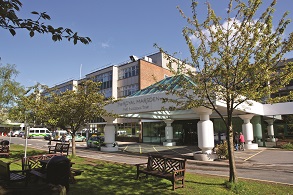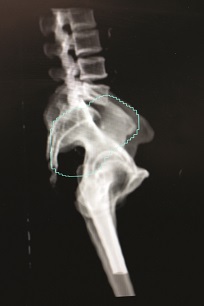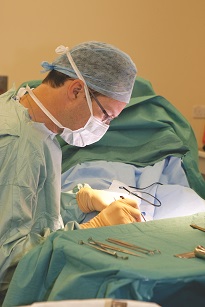Feature / Screen test
Screening to diagnose some common cancers earlier is just one aspect of a wide-ranging new model of care being trialled as part of the national vanguard programme. Steve Brown reports
Cancer services provide a good example of the challenge facing the whole NHS – in fact, they
of the challenge facing the whole NHS – in fact, they
may well face even more of an uphill struggle to deliver sustainable services than other specialties. Incidence of cancer is growing by 2% a year and costs are expected to rise by 9% a year if nothing changes. And while standards of treatment are often good, albeit variable, outcomes in terms of mortality rates compare poorly with other countries – largely due to later diagnosis and poor public health and prevention.
The national cancer strategy, published by an independent taskforce in 2015, set out a five-year plan of reform. Its proposals were widely welcomed and included: better prevention; earlier diagnosis; more focus on patient experience; more support for people living with and beyond cancer; more investment in equipment and workforce; and overhauling commissioning and provision with pilots to test new models of care.
So it should be no surprise that when NHS England asked for applications to be vanguards, it received three looking to test out new models for cancer provision. In fact, NHS England asked the three providers – The Royal Marsden NHS Foundation Trust, University College London Hospitals NHS Foundation Trust and The Christie NHS Foundation Trust – to combine their work in a joint vanguard.
So the trusts have been working together on some activities and following different paths elsewhere to enable the approaches to be compared and contrasted and then, potentially, rolled out across other providers.
Marcus Thorman (above), chief financial officer at the Royal Marsden, says there are three focus areas for the trust. It needs to change the system architecture, transform the clinical model and implement enabling infrastructure.
By system architecture, he means structures, contractual arrangements and governance around the delivery of cancer. And enabling infrastructure will cover the underpinning IT (including an exchange system for imaging), making better use of outcomes and performance data as part of business as usual, and ensuring services have access to the right number of appropriately skilled staff.
‘In terms of system architecture, we have had a commissioner-provider model for several years, with providers often doing their own thing – doing the best they can for patients in their part of the pathway,’ says Mr Thorman. ‘But that often leads to duplication and a sub-optimal overall pathway.’
Instead, the aim is to bring all the cancer services together into an accountable care network. West London has 24 providers of cancer care, including acute hospitals, cancer centres, cancer units, hospices and community providers. And it is likely the Royal Marsden will take on a lead provider role in what is being called RM Partners. The Christie is also exploring a lead provider model, while UCLH is considering some form of alliance approach.
‘We’re looking to take the resources for the whole of west London for cancer care and use that resource in a better, more efficient way,’ says Mr Thorman. The point is not about creating more work for the Marsden, he adds. In fact, its constrained footprint in Sutton in south west London means it has already been looking at ways to keep people out of hospital or reduce the number of visits they must make.
‘However the current payment system and tariff doesn’t incentivise us to make these changes,’ he says. ‘It hasn’t stopped us from making the changes, but they have caused financial issues.’ For example, 3,000 women treated for breast cancer, but rated as low risk for a recurrence, have been transferred onto an open access community model. This replaces follow-ups in hospital, which are costly and can cause unnecessary anxiety for women. While this is better for the patients, the trust loses outpatient income.
This has added to more general financial pressures. The trust typically has a more complex casemix than non-specialist hospitals and says that in many areas treatment costs are higher than the tariff paid. The trust’s ability to stay in surplus has relied to an extent on its large private practice – which represents about 25% of total revenues – and a strong charity that has helped with key assets. But surpluses in recent years have been declining and this year’s breakeven plan will be tough to deliver.
Transforming services
Going forward, Mr Thorman is clear that sustainable services completely depend on transforming service delivery. The trust will initially rely largely on traditional savings to meet the 2% efficiency expectation on all trusts set out in the Five-year forward view – providers’ contribution to the £22bn savings challenge by 2020/21. But it will need early wins from the improved system architecture – eliminating waste from duplicated scans, for example – to make a contribution in 2017/18.
And by 2019/20, it will be heavily dependent on efficiencies from the new clinical model to make the 2% target. Getting up to the 3% envisaged in the forward view for the later years of the period will need savings from areas outside the current vanguard scope.
Early work has seen the three vanguard trusts collaborate to analyse rich data that is already collected for cancer services. This includes data from the cancer outcomes and services and the systemic anti-cancer therapy datasets – comprehensive datasets that are generally under-used for informing service change. ‘Our analytics team have been able to benchmark for each bit of this data,’ says the Marsden’s chief nurse and vanguard executive director, Shelley Dolan. ‘So for men with prostate cancer we can look at where delays are in the pathway across all of London and all of Greater Manchester by clinical commissioning groups and provider.’
This flags up potential good practice to be copied and can help clinicians to understand the performance of their teams. It can also highlight patient experience issues too, such as the impacts of access to clinical nurse specialists or to the holistic needs assessment.
The vanguard trusts have also worked together to look at the demand and capacity for imaging and endoscopy – at the heart of plans to improve early diagnosis rates.
‘Anecdotally we would hear there were delays in the system because all the scanners were being used for A&E or cardiac patients,’ says Dr Dolan. ‘We did an important piece of work across all three patches to identify the actual issues and to take a five-year forward view too.
‘This helps us to set the baseline on capacity and to understand how we can work differently to use that capacity to meet demand and what new capacity we might need.’
Early diagnosis is a key focus for the vanguard. The cancer strategy highlighted that, for example, more than nine out of 10 people with bowel cancer survive at least 10 years if diagnosed at the earliest stage. But if diagnosed at a late stage, survival is below 5%. Yet fewer than one in 10 people are currently diagnosed at the earliest stage.
There is similar trend for lung cancer and many other types of cancer. Cancer Research UK estimates there would be a 0.5% increase in 10-year cancer survival for every 1% increase in the proportion of patients diagnosed at the earliest stages (1 or 2) across all cancers.
But as well as clear and significant improvements in outcomes, there is often a financial benefit too. Dr Dolan says expensive radiotherapy and chemotherapy treatments for stage 3 and 4 cancers can be replaced by surgery or single-application radiotherapy to remove small nodes in early stage cases. ‘It is much less costly and the outcome so improved as to be not comparable.’
The treatment costs for some cancers can be so different – typically £20,000 per case for a stage 4 colorectal treatment compared with closer to £12,000 at stage 1 – that the financial case even stacks up when you take into account the increased cost of early screening.
Early diagnosis
The vanguard plans to use targeted screening to improve early diagnosis of lung cancer – focusing on high-risk smokers and offering a low-dose CT scan screening programme. ‘There are added advantages, as you can also pick up concomitant non-cancer conditions such as early chronic obstructive pulmonary disease, and there is an opportunity to convince the participants to stop smoking, to provide a wider health benefit,’ Dr Dolan says.
This programme will be taken forward locally through CCGs. The aim is to use some vanguard funding but to keep costs down by using scanners in protected times at the end of a day or the weekend, avoiding extra capital costs for new scanners. Referrals to this screening would be direct from GPs.
‘We are also looking at mobile CT, as has been done with breast screening. This tends to be used with big national screening programmes, but we will look at it, though still on the basis of referrals. We want to get on with it as soon as we can,’ she says.
The new model also aims to provide access to 24/7 palliative care, but one of its main strands will look to reduce variation in treatment. The cancer networks in each of the three vanguard trust areas publish guidelines on how particular cancers should be treated along various timelines. These guidelines spell out in more detail than national access targets how to treat patients, using timed exemplar pathways. The aim is to agree and establish the same guidelines across the whole vanguard.
‘We are looking with teams right across the pathway – by tumour type – to see where the delays and gaps are. Is it clinician behaviour or a backlog issue? Is it because A&E performance is being prioritised? We are looking at all those things and asking how we can unblock things,’ syas Dr Dolan.
The trust is targeting an early win by reducing duplication of investigations. ‘There is a lot of repeat scanning, which causes delays, isn’t great for the patient and costs lots of money,’ she says. ‘This is not about blame. Sometimes unnecessary scans can’t be helped – you don’t always know what you’re looking for and a scan only becomes unnecessary with the benefit of hindsight.’ Consistent adherence to guidelines should eliminate much of this waste.
Another project is looking at dose banding for chemotherapy. Currently chemotherapy drug doses are matched to specific patients based on height and weight, but dose banding would band patients. All patients (apart from certain cases) in that band would then receive the same dose. Dr Dolan says this has the potential to save time and money with no impact on patients.
She believes that the current financial environment adds to the challenge. ‘We can identify the right thing to do in terms of better outcomes and saving costs over time, but in the short term we may be talking about invest to save and in today’s environment that is really hard, because everybody is just trying to survive,’ she says.
Having the national teams supporting the vanguard is important, she adds, in terms of understanding both the short-term costs and longer term benefits of making changes.
The current financial environment also means getting a revised payment model in place will be crucial. Get it right and it will underpin and incentivise new model working. Get it wrong and there is the danger of destabilising existing providers or the whole system (see box page 16).
‘We are not trying to save money compared with what we are currently spending,’ says Mr Thorman. Given the 2% rising incidence and estimated 9% rising costs, this would be unrealistic. ‘But we are trying to reduce the cost per individual with cancer. The fact of the matter is that we need to bend the cost curve to treat more people with the same amount of money.’
He is hopeful of some early wins particularly around earlier diagnosis and reductions in unnecessary imaging. But he believes it will be a year or 18 months before they will know if the new approach is starting to deliver as planned on the broader improvements.
Royal Marsden: revising payment
The change in payment  arrangements will
arrangements will
inevitably add financial risk for local providers and commissioners. And the task of designing a payment system is being led by the Royal Marsden’s associate director for financial
strategy implementation, Matt Backler. He says RM Partners are looking at various models – including alliances, lead provider, joint venture and integrated systems. ‘Lead provider does look most likely, but it is not finally decided yet,’ he says.
Scope is the key issue – what is in and what is out. And primary care is a major consideration. ‘Primary care is hugely important,’ says Mr Backler. ‘I’m not sure we can include it directly in the payment system, but we absolutely have to understand the primary care resource and have them involved and at the table.’ NHS England has a place in the development team and there are also a number of GPs involved.
Spend on acute services, whether with the Royal Marsden or one of the other cancer providers such as Imperial, St George’s, Chelsea and Westminster or Hillingdon, is relatively straightforward. However, even here there are likely to be complications – for example, cancer patients coming to accident and emergency and being coded as a cancer patient but treated for something else.
Mr Backler says palliative care is another issue. ‘We are committed to providing access to seven-day palliative care,’ he says. ‘But can we have a different model – and payment system – for cancer and non-cancer services? We are very much in the foothills with this process at the moment. We are aware of all the questions but we are only just starting the work.’
In fact, the trust was tendering for support over the summer. The payment system needs to enable providers to cover costs, but it also needs to support changes in the service model where this is the right thing to do. So if there was a plan to centralise or decentralise a service, the payment system would need to be flexible enough to support it.
A gain and loss sharing mechanism will be needed to underpin the whole set-up. Mr Backler believes this would need to work at two levels – a global level, so that overspends or underspends are shared across commissioners and all the providers involved; and a more granular level, so that risk and reward is proportionate to the ability to affect the outcomes. For example, if services were transferred from one provider to another in a patch, the gain/loss might need to be shared across specific providers and the relevant commissioners.
An element of payment will also be linked to outcomes and this will needed to be cascaded down to all the contributing providers. ‘For example, if a proportion of payment was linked to one-year survival rates, this would need to be mirrored down into sub-contracts.’ However, he anticipates it being more sophisticated than a single set of outcomes, the achievement of which triggers payment across all providers.
There are other issues to be addressed. Identifying current spend on in-scope cancer services provides a baseline. But if that budget is based on tariff prices that underestimate the real costs of care, the new system will start life in deficit. And the cancer strategy, based on assumptions for forecasts in the Five-year forward view, suggests cancer spend will grow by around 9% a year over the next five years.

Clearly some of the actions proposed by the cancer strategy and being takenforward by the vanguard are intended to suppress some of this cost growth – but what is the right amount of inflation to build into contracts – to cover providers’ appropriate costs and encourage greater efficiency? Again, Mr Backler suggests the gain share mechanism between commissioners and providers could be crucial, with a proportion of under spends being shared back with commissioners.
The vanguard only received details of its £7m vanguard funding in May and is still targeting next April for some form of change to its payment system. Mr Backler says it is unlikely this will be a big bang implementation next April for what could be a budget of £350m to £500m, but it could involve shadow running or focusing on a single pathway.
National Orthopaedic Alliance: joint work
The core aim of the National 
Orthopaedic Alliance – another acute care
collaboration vanguard – is to set out what good practice
in specific orthopaedic pathways looks like and
then award quality standards to providers
that meet those requirements.
The vanguard was launched by the Robert Jones and Agnes Hunt and Royal Orthopaedic Hospital NHS foundation trusts and the Royal National Orthopaedic Hospital NHS Trust. But two other major orthopaedic providers quickly joined – Nuffield Orthopaedic Centre (part of Oxford University Hospitals NHS Trust) and Wrightington, Wigan and Leigh NHS Foundation Trust. And there are a further nine associate members. Together they are focused completely on the practical aspects of establishing and then implementing best practice across the expanding membership.
There is wide recognition of significant potential to improve orthopaedic services for patients and increase value. It is the health service’s biggest surgical specialty with the biggest spend and the longest waits. Recent years have also seen an explosion in data about musculoskeletal services.
While RightCare data has provided this from a commissioner perspective, the Getting it right first time (GIRFT) initiative has shone a spotlight on variation in practice across England’s orthopaedic providers. This data has been wide-ranging. For example, it has revealed high proportions of surgeons doing only small amounts of activity for some procedures. It has shown wide-ranging prices paid for the same prostheses and underuse of more cost-effective cemented joints for appropriate hip replacements. And it has put a spotlight
on application of known good practice such as ringfenced beds for elective activity.
The vanguard now aims to build on the GIRFT work. ‘They will mutually reinforce each other,’ says Rob Hurd, chief executive of the Royal National Orthopaedic Hospital NHS Trust. GIRFT provides the initial data to highlight variation and opportunity. The vanguard will show what best practice looks like and support its achievement. Then the GIRFT data, through quarterly dashboards, will demonstrate the achievement and maintenance of improved outcomes and efficiency.
Mr Hurd says the GIRFT initiative and pilot programme was all about normalising the publication and sharing of data and ‘winning the hearts and minds of clinicians about where there was unwarranted variation. The vanguard is now about bringing the organisations in’.
‘We are talking about the management of the orthopaedic department and multidisciplinary teams running those services,’ he says. ‘We want them self-assessing against the standards, joining up to this membership model and sharing best practice at a very detailed level. There is a lot of benchmarking that goes on, but making it real and turning it into best practice is what this vanguard is all about.’
The vanguard will define best practice pathways in its key service areas – spines; hips and knees; sports injuries; foot and ankle; shoulders; orthopaedic cancers; bone infections; pain services; rehabilitation; and rheumatology. There may be anything from two to 10 high-volume procedures or treatments in each area. And the vanguard will set best practice across the whole pathway, from referral and preoperative assessment to discharge, measuring outcomes and involving patients in shared decision-making.
The quality standard approach has yet to be finalised but could see organisations awarded a bronze, silver or gold rating, depending on how they measure up against the standards in a particular pathway. At bronze, an organisation might have identified its development opportunities and have an improvement plan in place. A gold mark would indicate that it is meeting all the standards in a specific pathway and is evidencing the outcomes being achieved.
The identification of best practice is being led by clinicians, who have been collating and comparing existing approaches alongside existing standards set by the British Orthopaedic Association. First agreed standards should be published this autumn. The agreement of expected outcomes will be a key part of the process and could pave the way for aspects of the future payment system to be linked to outcomes.
Related content
The Institute’s annual costing conference provides the NHS with the latest developments and guidance in NHS costing.
The value masterclass shares examples of organisations and systems that have pursued a value-driven approach and the results they have achieved.